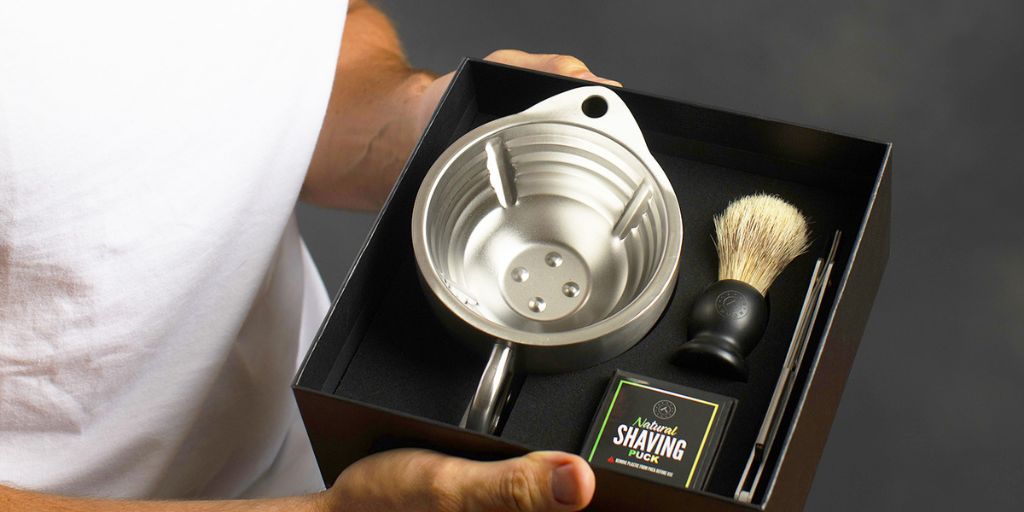How To Lather Shaving Soap: Simple Lathering Guide

Every man's shaving journey is his own and is perfected over time. Because of this, traditional methods are coming back in modern times as more people want to learn how to lather shaving soap again instead of using ready-made foam from a can.
Shaving soaps are an essential part of the multi-million dollar industry of self-care products for men but only account for a small portion of the total sales.1 Choosing one can be overwhelming, so learning more about shave soaps, how to use them, and why you should get one is essential.
This article shows how to get the perfect lather for wet shaving:
- What Is Shaving Soap?
- Different Ways To Lather Shaving Soap
- How To Use A Shaving Brush
- Shaving Mugs Or Scuttles?
- Lathering Shaving Soap In A Tin Can
- Using Your Hands For Lathering Shave Soap
- Why Should You Use Shaving Soaps?
- Important Reminders
What Is Shaving Soap?
 Shaving soaps have high-fat content, low alkalinity, and natural ingredients for a thicker and moisturizing lather.
Shaving soaps have high-fat content, low alkalinity, and natural ingredients for a thicker and moisturizing lather.
Although shaving soaps came into the scene way before gels and canned foams, people are unfamiliar with them. Its presence has been overshadowed by its modern counterparts. That is also why you probably do not use it because you do not know much about it.
Shaving soaps are technically hard soaps you use to lather the foam you apply to your skin while shaving. Unlike an average bar of soap,2 it can produce a thicker and richer lather because shaving soaps have high-fat content and low alkalinity.3
Some key ingredients in shaving soaps are fat from plant or animal sources, such as glycerin or coconut oil. These all offer moisturizing benefits and nourishment for your skin and even condition different hair types.4 It also accounts for the soap’s smooth consistency, making it work best as a lubricant.
Why Can't I Use Normal Soap To Shave?
Shaving with regular soap is not recommended because it does not lubricate or soften hair like shaving cream, gel, or soap does. It is more likely to cause irritation, nicks, and cuts. When you use regular body soap, your skin dries out, which increases your chances of getting razor burn. To get a close shave without the risk of skin irritation, it would be best to use shaving products specially formulated for that purpose.
What Makes A Good Shaving Soap?
Shaving soaps aren't exempt to the fact that industrialization and mass production can make products of lower quality. So, there's no reason not to want to know about what makes a good shaving soap.
You shouldn't settle for low quality just because it's inexpensive. Looking for a bar of shaving soap will require some diligence on your part. Consider the soap's ingredients at all times and be careful of potentially harmful substances and components you may be allergic to.
Below are some toxic ingredients5 you should avoid:
- Propylene glycol - used like glycerin to preserve moisture
- Triethanolamine (TEA) - emulsifying agent
- Sodium Lauryl Sulfate (SLS) - detergent and lathering agent
- Sodium Laureth Sulfate (SLES) - a gentler version of SLS
- Mineral oil - petroleum byproduct; alternative for plant-based oils
- Synthetic fragrance and coloring
A high-quality shave soap, especially one made from all-natural ingredients, is the key to getting a healthy, moisturized, clean-shaven face.
Also, some shaving soaps contain essential oils that could cause skin irritation. Here are the common shaving essential oils that may also be incorporated into shaving soaps:
- Grapefruit Oil
- Eucalyptus Oil
- Lavender Oil
- Rosemary Oil
- Tea Tree Oil
- Sandalwood Oil
- Sage Oil
- Vanilla Oil
- Lime Oil
- Peppermint Oil
The best shaving soap on the market is made with natural ingredients and has few or no harmful chemicals. If you have allergies to any of the ingredients listed, then the product without those ingredients will be the best option. You can try one that you think will work on every skin type.6
How long it takes to lather shaving soap depends on the type of soap, how much water and soap you use, what kind of brush you use, and whether you are using hard water. A good lather should take about one to two minutes to make—or faster if using a brush.7 If you've never used a shaving brush or soap before and are new to wet shaving, getting the timing and consistency of the lather right might take some practice.
Different Ways To Lather Shaving Soap
To create a good lather with shave soap, you will need a shaving brush, shave soap, warm water, and a shaving bowl, mug, or scuttle (optional). Then, follow these steps on how to lather shaving soap:
How To Use A Shaving Brush
A shaving brush is a tool used to apply shaving cream or gel to the face before shaving. Shaving brushes have handles and bristles made of materials like synthetic fibers and natural hair from badger, boar, or horse. Some wet shavers prefer synthetic brushes to those with natural bristles due to the smell. Nonetheless, with the bristles, you can make a rich lather and spread it all over your face, preventing dry skin, which makes shaving easier.
Shaving Mugs Or Scuttles
Many people are confused about the difference between shaving mugs and scuttles. A shaving bowl or mug is the original “cup” you use to lather soap and contain your shaving foam. You can also use it as a cup for the hot water you need while shaving. Meanwhile, a shaving scuttle is an improved version of a shaving mug divided into two parts, one containing the foam and the other holding the warm water.
You should also invest in these accessories to achieve a barber-like lather for your shaving needs. However, if you are a young man just starting his wet shaving journey, you can save up for now and just use your hands or lather it in a regular mug or directly onto a shaving soap tin.
With that in mind, here are some ways to lather shaving soap with a brush and scuttle:
- You want to heat water first. Warm water will make it easier to make a perfect, creamy lather for shaving and make your skin and hair easier to shave.
- Put your soap puck in your scuttle. Remove the thin plastic first if you're using the shaving soap puck from Naked Armor. For a smooth swirling motion, the puck needs to fit into the ridges of the scuttle, and the scuttle shouldn't be too big or too small for the soap.
- Bloom the shaving soap by putting a small amount of warm water over the surface, allowing it to soften and become flexible. Put the rest of the water inside the scuttle's inner chamber and seal it with a cork.
- Soak or wet the brush before use to make the bristles more porous, remember to shake off or gently squeeze any excess water before loading it with soap.
- Swirl your wet brush bristles over the bloomed soap puck in a circular motion with a bit of pressure to create a thick and rich lather.
- Start applying your warm lather when you get a thick, creamy lather consistency that is not too thick or runny. We recommend mapping your face as you go.
- Rinse the scuttle and brush after shaving, and simply leave your brush on a razor and brush stand to dry it properly.
Lathering Shaving Soap In A Tin Can
Compared to using a soap puck to create a lather, lathering on a tin of shave soap is less complicated.
- Prepare your brush bristles by dipping them in a cup of water. Don't let it absorb too much water to prevent a runny lather.
- Swirl your shave brush over the soap tin, add a few drops of water, and keep stirring until the mixture is just right if needed.
- Load your brush with the thick lather, and then use it to spread the lather in a circular motion on the parts of your face you want to shave, like your chin, cheeks, and neck.
Now you can use your preferred razor to get a close shave. We recommend using a straight razor instead of cartridge razors to avoid any foam getting stuck between layers of blades.
Using Your Hands in Lathering Shave Soap
While a shaving brush is the standard tool for lathering shaving soap, you can get the job done with just your hands. You can get started by following these steps:
- Wet your hands with warm water to help melt the soap.
- Apply a light coating of soap by rubbing a small amount of shaving soap between your hands.
- Rub your hands together hard and, if needed, add more water to make a lather. Doing this may take a few minutes to make a thick, creamy lather.
- Use your hands to apply a thick layer of lather on your face and work it into your beard by making circles.
- Shave following your usual shaving routine, then rinse your razor often to get rid of any hair or lather that has built up.
Using your hands to lather shave soap can be a good option if you don't have a brush, but it may provide a different exfoliation and massage than a high-quality brush.
Why Should You Use Shaving Soaps?
Shaving soaps offer a stiffer, fluffy lather, creating a cushion between the razor and your face. Dermatologists say combining a high-quality razor and shaving soap is ideal for reducing the risk of cuts and irritation.8 A shaving soap allows your razor to glide faster and more smoothly across the skin, and it makes shaving hassle-free and protects your skin.
You have more control over how much, how thick, and how much air is in your lather when you use shaving soap. It also cleans and hydrates your face to get a great shave and a clean face for a straight razor shave, making it popular among wet shavers.
For the best shave, it's important to familiarize yourself with the benefits of using shaving soap, such as:
It Moisturizes Your Facial Hair
Shaving soap helps hydrate and moisturize your face during a shave, making those tough, thick facial hairs softer and more comfortable to cut.9 The less force you exert, the more comfortable your shave will be.
Shaving soaps include moisturizing ingredients that keep your skin hydrated and soften your hair for a more comfortable shave and post-shave feel. You no longer have to worry about irritation, pain, or swelling you might get after you shave. Shaving soaps have soothing effects that your skin needs.
It Lubricates Your Skin
Shaving soap removes the beard’s oil using a brush, allowing water to penetrate the facial hair. As a result, it is easier to shave and remove hair without hassle than using gels, canned shaving creams, or foams.
As an emollient, shaving soap’s thin layer of protection between the razor and your skin ensures minor irritation and friction.10 This quality of the combination of a clean, sharp razor and shaving soap decreases the risk of razor burn and prevents your razor from chopping or skipping across your skin.
It Leaves Your Skin Feeling Refreshed
As you shave off a line of shaving soap, you can distinguish the areas of your face that are shaved and unshaved. This visual aid means fewer missed spots and fewer trim lines of hair you only catch later when you are out in public.
Natural shaving soaps containing Vitamin E and avocado oil are highly recommended, especially for sensitive skin.11 These are gentle and can refresh and calm the skin while allowing a close shave.
Important Reminders
 Naked Armor's Silver Fox Scuttle Kit has everything that you need for a very relaxing wet shave.
Naked Armor's Silver Fox Scuttle Kit has everything that you need for a very relaxing wet shave.
Most men view shaving as more than just a daily ritual. You have to find the right and best way to shave for you, which can take some trial and error. You must know and master what to do before, during, and after shaving your facial hair. This includes applying pre-shave oil, making a perfect lather, perfecting your shaving skills to avoid skin pain, swelling, and irritation, and applying aftershave to avoid razor burn.
By mastering the art of shaving, you can turn a mundane daily routine into a satisfying self-care ritual. Taking care of your skin may do more than just make you look and feel better; it can also boost your confidence and make you feel ready to take on the day.
For the best shaving experience, use Naked Armor's Silver Fox Scuttle Kit or Savanna Scuttle Kit. The stainless steel and ceramic double-chambered scuttles will warm your lather throughout your shave. It comes with our signature organic shaving soap and badger-friendly brush to help you achieve a close, comfortable shave by creating the thickest, creamiest lather.
Add to Cart Below:
References:
- The US Men’s Shaving Cream Market: A Competitive Profile. Chinese Business Review, ISSN 1537-1506. January 2012, Vol. 11, No. 1, 44-64 http://www.davidpublisher.com/Public/uploads/Contribute/5513c8a360579.pdf
- H. Wicker. How is Shaving Soap Different Than Regular Soap? West Coast Shaving. https://www.westcoastshaving.com/blogs/wet-shaving-and-grooming-blog/how-is-shaving-soap-different-than-regular-soap
- Shaving Soap Definition and Meaning. Dictionary. https://www.dictionary.com/browse/shaving-soap
- E. Arata. Beard Styles And Facial Hair Types: The Complete 2023 Guide. Hair by L’oreal. https://www.hair.com/facial-hair-types.html
- E. Sennebogen. Are there harmful chemicals in shaving cream? How Stuff Works. https://health.howstuffworks.com/skin-care/men/shaving-tips/chemicals-in-shaving-cream.htm
- A. Stuart. What’s Your Skin Type? WebMD. https://www.webmd.com/beauty/whats-your-skin-type. October 13, 2021
- Create The Perfect Lather. Gentleman Jon. https://www.gentjon.com/pages/how-to-create-the-perfect-shave-lather
- 6 Razor Bump Prevention Tips From Dermatologists. American Academy of Dermatology. https://www.aad.org/public/everyday-care/skin-care-basics/hair/razor-bump-prevention
- M. Burke. 6 Reasons Why You Need a Shaving Soap in Your Life. Perfectly Natural Soap. https://www.perfectlynaturalsoap.com/blogs/news/6-reasons-why-you-need-a-shaving-soap-in-your-life
- What’s the Best Way to Use an Emollient? Healthline. https://www.healthline.com/health/emollient. September 29, 2018
- C. Whelan. Vitamin E and Your Skin, Friends Through Food. Healthline. https://www.healthline.com/health/vitamin-e-for-skin#the-takeaway



























Leave a comment